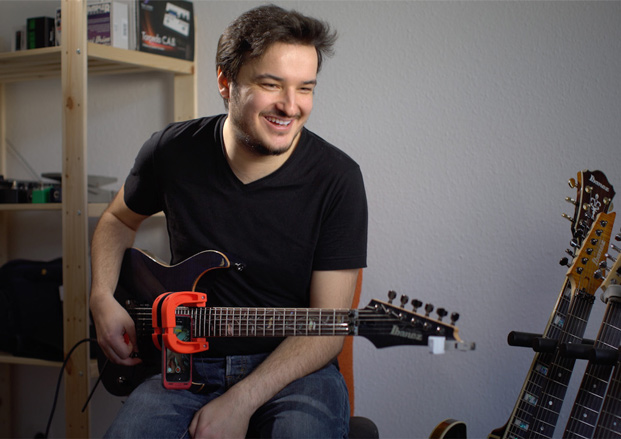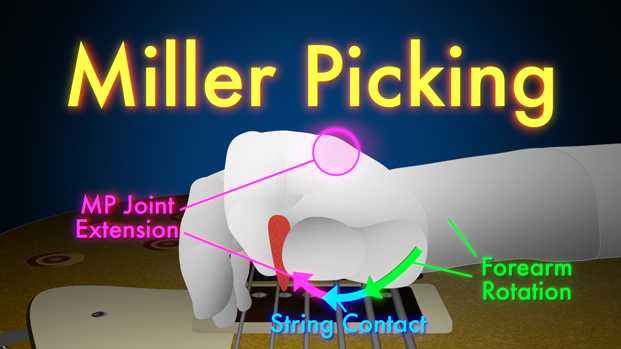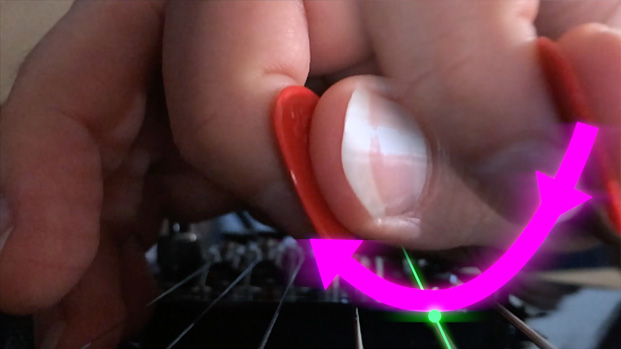Martin Miller's 21st-Century Picking Mechanics
Martin Miller's seemingly effortless command of picking mechanics represents the future of what we can all expect a good guitar player to be able to do.

As lead guitarists, we often chase the elusive ideal of one picking technique that lets us "play anything."
This is an illusion, of course. Everything in guitar land is to a certain extent rehearsed, from picking sequences to complex fretboard maps for improvising through chord changes.
But if there's a more effective illusionist than Martin Miller, we've yet to meet them. Miller's seemingly effortless command of picking mechanics represents the future of what we can all expect a good guitar player to be able to do:
Escaping the Glass Prison
In particular, Miller executes one note-per-string sequences with a level of ease and accuracy that we probably didn’t even know was possible a couple decades ago:
This is, of course, a section of John Petrucci's classic arpeggio sequence from the Dream Theater song "The Glass Prison." It's a notoriously daunting example of right-hand technique, as Petrucci employs Yngwie-style, three-string arpeggio shapes, but tackles them with alternate picking instead of sweeping:
The ability to do this quickly is among the most rare of picking skills. Even elite players commonly handle tricky phrases like this with a combination of sweeping, alternate picking and legato. But Miller's ability to do this with alternate picking alone, at tempos exceeding 160bpm sixteenth notes, and with apparently very little mechanical effort, is nothing short of wondrous. How on earth is he doing it?
Miller Picking
The answer is fascinating. Miller uses an unusual combination of forearm, wrist, and finger movements to target the pick at the precise string without hitting any of the surrounding ones:
The unique look of Miller's finger-driven picking technique was unmistakeable when sitting down with him in person, and especially so in slow motion. The system is so effective at handling intricate picking passages at high speed, and so fundamental to Miller's playing, we've christened it "Miller Picking." Here's a handy (pun intended) infographic of the system in action:

In the Miller Picking approach, the pickstroke starts in the air, and uses forearm rotation to swoop down to hit the strings. Then, after the note has been played, the fingers take over and lift the pick back up out of the strings again. This creates a distinctly curved trajectory:

You might recognize this semi-circular picking movement from our interviews with Steve Morse and Carl Miner, both of whom we've written about here at GuitarWorld.com. All these approaches represent a class of picking movements we call "crosspicking," and they are the key to navigating one-note-per-string sequences without hitting any of the surrounding strings.
The twist in Miller's case is the way he's producing the trademark crosspicking curve. Specifically, Miller uses index finger extension at the metacarpophalangeal joint, or the "MP" joint, for short:

The MP joint is the connection between the metacarpal bones of the palm, and the phalanges, or finger bones. Mercifully, we'll use the abbreviation!
Extending the MP joint raises the index finger, and flexing it lowers it. In combination with thumb lifting, or "adduction," Miller can raise the pick upward so he doesn't crash into the next higher string when he plays a downstroke. On the upstroke, the process is reversed: the MP joint flexes, and the thumb abducts.
Miller's Magic
The system is so easy for Martin to execute, and so reliable, that small variations in consistency don't often produce wrong notes, even over long passages like this blazing keyboard-inspired Steve Morse lick from Deep Purple's "Cascades: I'm Not Your Lover":
- We used to think this level of virtuosity was a rare genetic superiority possessed by an elite few. And to be sure, Miller's ability to engineer a new approach to accurate picking, completely by feel, is certainly the product of his unique talent. But the actual picking movement itself is just that: a movement, and one we can now easily see, even on a phone. And thanks to Miller's incredible generosity, the rest of us now have a fighting chance of actually doing it.
You can watch the full-length Martin Miller interview, with more than 100 slow motion examples and tablature, as well as downloadable versions of the interview and the 15-minute analysis video, in Masters in Mechanics.
Troy Grady is the creator of Cracking the Code, a documentary series with a unique analytical approach to understanding guitar technique. Melding archival footage, in-depth interviews, painstakingly crafted animation and custom soundtrack, it’s a pop-science investigation of an age-old mystery: Why are some players seemingly super-powered?
Get The Pick Newsletter
All the latest guitar news, interviews, lessons, reviews, deals and more, direct to your inbox!
Troy Grady is the creator of Cracking the Code, a documentary series with a unique analytical approach to understanding guitar technique. Melding archival footage, in-depth interviews, painstakingly crafted animation and custom soundtrack, it’s a pop-science investigation of an age-old mystery: Why are some players seemingly super-powered?










